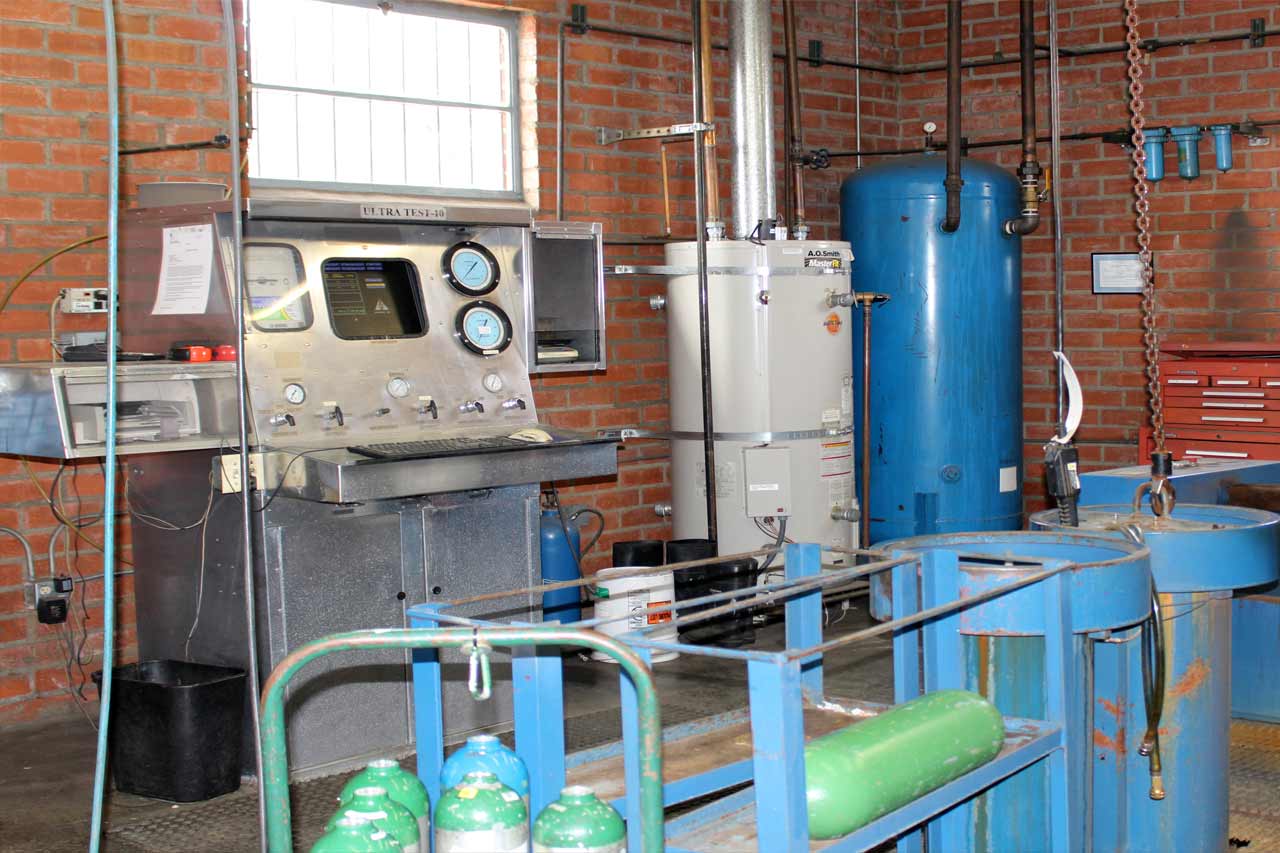
Gas Cylinder Safety and Testing
Compressed gases are stored in heavy-walled metal cylinders designed, produced and tested for use with compressed gases. Inside the cylinder the stored contents may be in a state of compressed gas, vapor over liquid, supercritical fluid, or dissolved in a substrate material, depending on the physical characteristics of the contents.
A typical gas cylinder design is elongated, standing upright on a flattened bottom end, with the valve and fitting at the top for connecting to the receiving apparatus.
Cylinders are made in a wide variety of sizes and shapes. They range from small lecture bottles, often used for demonstration purposes, to large cylinders over ten feet long.
Usually, cylinders must be retested or inspected every five or ten years. The date of each test must be stamped on the cylinder.
Safety Precautions
When using compressed gas cylinders, the following precautions shall be followed at all times:
- Only properly trained employees shall handle and/or use compressed gas cylinders.
- Cylinders shall not be used as rollers, supports, or for any purpose other than to contain and use the contents as received.
- Employees and other personnel shall keep all open flames and heat sources away from medical oxygen tanks, oxygen machines or concentrators, and oxygen tubing.
- Repair or alteration of compressed gas cylinders is prohibited.
- Cylinders shall not be placed where they might become part of an electrical circuit. When compressed gas containers are used in conjunction with electric welding, they shall not be grounded or used for grounding.
- Compressed gas containers shall not be exposed to temperature extremes.
- If compressed gas containers have been exposed to fire, contact the supplier immediately.
- All tubing shall be periodically checked for integrity. If tubing is damaged, cracked, or missing, it shall be removed from service until properly repaired or replaced.
- When a container or valve is noticeably corroded, dented, cut, damaged, or involved in an accident, notify the supplier.
- Gases shall not be transferred from one compressed gas cylinder to another. Do not try to refill a compressed gas cylinder.
- Disposable gas cylinders, including lecture bottles, shall not be refilled. It is against U.S. Department of Transportation regulations to refill or reuse a disposable gas cylinder.
Testing
The U.S. Department of Transportation requires that gas cylinders be tested on a regular basis, internally and externally, to ensure proper safety when handling. Because of the flammable state of many of the gases, any inconsistencies can be a safety hazard.
The Department of Transportation and Pipeline Hazardous Materials and Safety Administration regulate the transport of hazardous materials. Each cylinder used for the transportation of hazardous materials must be an authorized packaging.
Every five or ten years, a standard DOT-rated cylinder must be requalified before it can be filled and transported by one of two accepted methods. The first method is a volumetric expansion test to determine the elasticity of the cylinders. The other option is an ultrasonic inspection that scans the cylinder and checks for defects in the metal and compares the average wall thickness against the manufacturer’s specifications and a calibration of a similar metal.
If the cylinder passes either of these tests and a visual inspection, it is deemed to be an authorized package and can be stamped and filled for another service cycle.
Hydrotesting
A hydrostatic test involves vacating any residual gas from the cylinder, removing the valve, filling the cylinder with water, placing the cylinder into a sealed water environment, introducing pressure greater than that of the service pressure for a standard period of time (usually 30 seconds), releasing the pressure and measuring the expansion (permanent and elastic), removing the cylinder from the sealed environment, emptying the water, drying the cylinder, performing an internal visual inspection, stamping the cylinder and reinstalling an acceptable valve (usually the same valve that was previously in the cylinder unless it does not conform to thread count specifications or having a service change done).
An ultrasonic test, by comparison, involves placing the cylinder in the ultrasonic machine and testing it under ideal circumstances (exterior in good condition, empty of liquified gases, valve closed).
Air Source Is a one-stop shop for all your steel, aluminum, composite and industrial gas tank repair and service. We provide state of the art testing and maintenance for cylinders. Some of the services we provide include:
- Maintenance
- Hydro-testing
- Cylinder valve replacements
- Shot-blasting
- Gas service changes
Testing is required for all cylinders and our expert staff at Air Source meets and exceeds those maintenance and safety requirements every day. When you choose Air Source to manage your compressed gas cylinders, you know you are in good hands and we take care of everything for you.
Air Source Industries offers high quality industrial and medical gases for your business in the greater Los Angeles area. Let our gas experts test your cylinders regularly and be your provider. For gas quotes, simply click “Get a Quote” or call us at (562) 426-4017.
Sources:
https://www.ccohs.ca/oshanswers/prevention/comp_gas.html
https://protect.iu.edu/environmental-health/occupational-safety/equipment/gas-cylinder.html
https://air-source.com/services/cylinder-repairs-testing
https://en.wikipedia.org/wiki/Gas_cylinder
https://gawdamedia.com/2019/09/20/compressed-gas-cylinder-maintenance-making-cylinders-last-beyond-100-years/
http://www.tymsinc.com/hydrostatic-faq.html
https://linde-stories.com/gas-cylinder-maintenance-the-untold-story/

